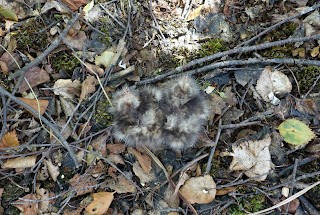Soil Hill
A pretty typical mid-June week with very little of note overall, but pleasant birding with many of the established migrants still around, lots of activity from the breeding waders and a few nice bits and pieces thrown in to keep things lively. Without doubt the standout of the week was a Nuthatch on Taylor Lane on the 9th. As I was walking up I heard the call, but was not 100% confident that it was indeed a Nuthatch, given that this would only be my third record here, but as I approached it flew out from the conifers and landed on a telegraph post on the opposite side of the road. Here I had just enough time to grab a few quick photos before it was flushed by a passing car. It then flew off towards the tall trees on Perseverence Lane. This week I also had two different Red Kite sightings, one on the 8th and another on the 9th. On the 8th a bird flew low and slow over Denholme Velvets, and may have dropped in but frustratingly I lost it while gathering my camera. The following day one was soaring well to north of Soil Hill, probably over Denholme, or possibly even further. A few Sand Martin and a Siskin rounded the week off nicely.
-Red Kite
-Nuthatch
Whiteholme Reservoir
Just one visit this week, with wader passage all but over and the distant and time it takes to visit this site made it all seem a little worthless. I'll be back to frequent visits come mid-July. There were a couple of Dunlin and a nice group of 5 Oystercatchers, but otherwise precious little of note.
Undisclosed Location
Thanks to gen from Mark Dovestone, it was a pleasure to see, and more importantly hear, a displaying Nightjar less than half an hour from my house. It seems crazy to think that I can hear a nightjar whilst looking at the Soil Hill mast! A fantastic evening recording one of these birds, my first in the UK since 2018, when I ringed chicks on Hatfield Moor.
-European Nightjar
Species List:
Soil Hill: Canada Goose, Mallard, Red-legged Partridge, Common Pheasant, Feral Pigeon, Stock Dove, Common Wood Pigeon, Common Swift, Common Moorhen, Eurasian Oystercatcher, Northern Lapwing, Eurasian Curlew, Common Snipe, Black-headed Gull, Lesser Black-backed Gull, European Herring Gull, Red Kite, Eurasian Magpie, Western Jackdaw, Rook, Carrion Crow, Eurasian Blue Tit, Great Tit, Eurasian Skylark, Barn Swallow, Sand Martin, Willow Warbler, Eurasian Blackcap, Common Whitethroat, Eurasian Wren, Eurasian Nuthatch, Common Starling, Mistle Thrush, Common Blackbird, European Robin, Dunnock, House Sparrow, Pied Wagtail, Meadow Pipit, Common Chaffinch, European Greenfinch, Common Linnet, European Goldfinch, Eurasian Siskin, Common Reed Bunting, Small Heath, Small Tortoiseshell, Orange Tip, Large Red Damselfly, Common Blue Damselfly,
Whiteholme Reservoir: Canada Goose, Mallard, Eurasian Oystercatcher, Northern Lapwing, Common Ringed Plover, Little Ringed Plover, Eurasian Curlew, Dunlin, Common Snipe, Lesser Black-backed Gull, Common Kestrel, Carrion Crow, Eurasian Skylark, Eurasian Wren, Pied Wagtail, Meadow Pipit, Common Reed Bunting,
Soil Hill: Canada Goose, Mallard, Red-legged Partridge, Common Pheasant, Feral Pigeon, Stock Dove, Common Wood Pigeon, Common Swift, Common Moorhen, Eurasian Oystercatcher, Northern Lapwing, Eurasian Curlew, Common Snipe, Black-headed Gull, Lesser Black-backed Gull, European Herring Gull, Red Kite, Eurasian Magpie, Western Jackdaw, Rook, Carrion Crow, Eurasian Blue Tit, Great Tit, Eurasian Skylark, Barn Swallow, Sand Martin, Willow Warbler, Eurasian Blackcap, Common Whitethroat, Eurasian Wren, Eurasian Nuthatch, Common Starling, Mistle Thrush, Common Blackbird, European Robin, Dunnock, House Sparrow, Pied Wagtail, Meadow Pipit, Common Chaffinch, European Greenfinch, Common Linnet, European Goldfinch, Eurasian Siskin, Common Reed Bunting, Small Heath, Small Tortoiseshell, Orange Tip, Large Red Damselfly, Common Blue Damselfly,
Whiteholme Reservoir: Canada Goose, Mallard, Eurasian Oystercatcher, Northern Lapwing, Common Ringed Plover, Little Ringed Plover, Eurasian Curlew, Dunlin, Common Snipe, Lesser Black-backed Gull, Common Kestrel, Carrion Crow, Eurasian Skylark, Eurasian Wren, Pied Wagtail, Meadow Pipit, Common Reed Bunting,





















































